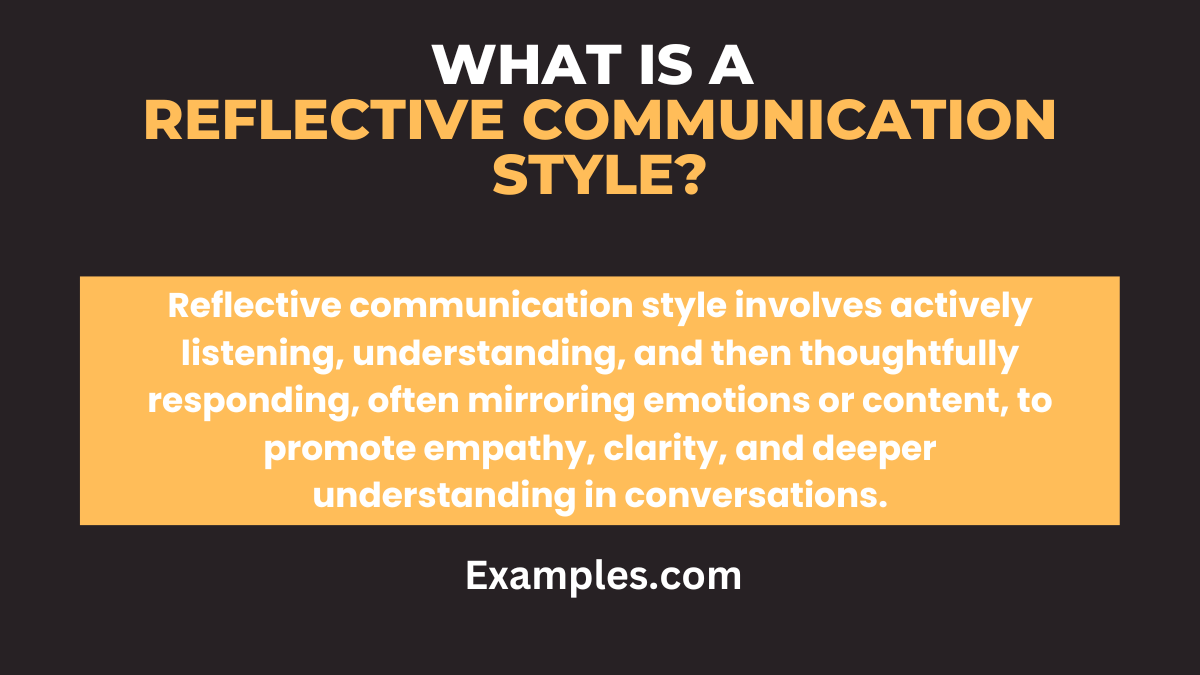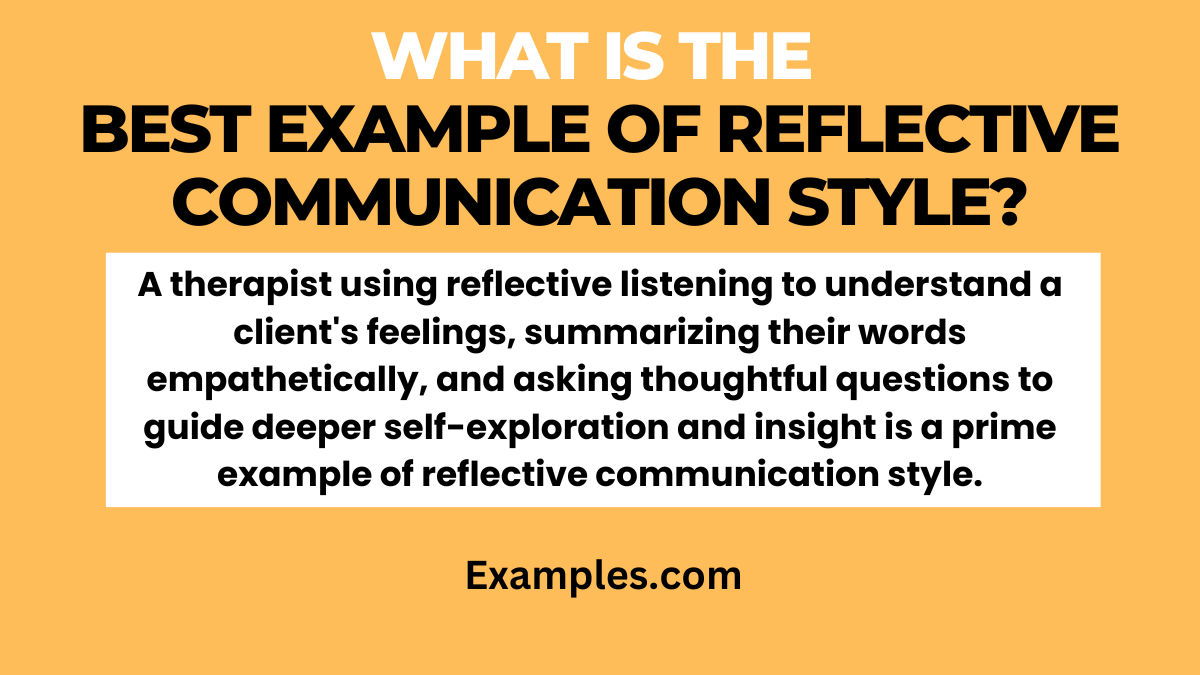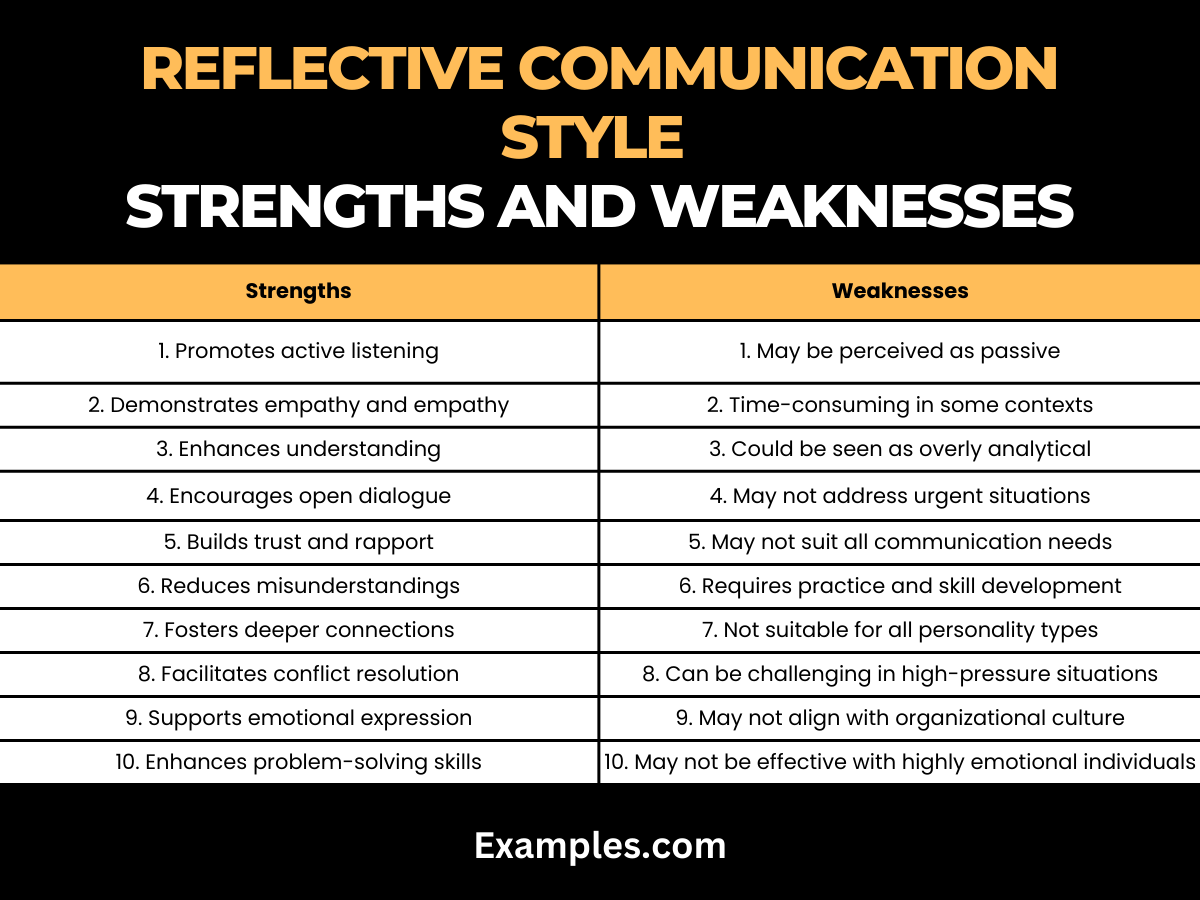Reflective Communication Style
Reflective Communication Style is a nuanced approach that emphasizes understanding and empathy in interactions. This complete guide, enriched with practical communication examples, explores the essence of reflective communication. It delves into how this style enhances interpersonal dynamics, fosters deeper connections, and improves listening skills. By offering real-life examples, this guide provides invaluable insights into adopting a reflective approach, vital for effective communication across various contexts, from personal relationships to professional environments.
Download Reflective Communication Style in PDFWhat is a Reflective Communication Style? – Definition

A Reflective Communication Style is a method of interacting where the focus is on actively listening and understanding the speaker’s message before responding. It involves thoughtfully considering the speaker’s words, then conveying that understanding back to them. This style is essential in interpersonal communication, as it demonstrates empathy and respect for the speaker’s perspective. Reflective communication is often used in scenarios requiring deep understanding and empathy, making it a valuable tool in both personal and professional settings.
What is the Best Example of Reflective Communication Style?

The best example of Reflective Communication Style is often seen in counseling or coaching sessions, where the listener (counselor or coach) focuses on understanding the speaker’s feelings and thoughts. In this scenario, the listener carefully listens to the speaker, processes the information, and then reflects it back. This might involve paraphrasing the speaker’s words or asking insightful questions to gain deeper clarity. Such reflective interactions are not limited to professional settings but are also valuable in everyday interpersonal communication. They allow the speaker to feel heard and understood, fostering a deeper connection and trust between the participants. This style is particularly effective in resolving conflicts, where understanding each other’s viewpoints is crucial.
20 Reflective Communication Style Examples

Reflective Communication Style is an approach emphasizing active listening and empathy, crucial in enhancing communication skills and interpersonal understanding. This guide offers 20 unique examples demonstrating reflective communication’s effectiveness in various contexts. From personal to professional interactions, these examples reveal how reflective listening and thoughtful responses can deepen understanding, build trust, and improve overall communication quality.
- In a Therapy Session
Understanding and empathizing with a client’s feelings.
Example: “It sounds like you’re feeling overwhelmed by these changes.” - During a Conflict Resolution Meeting
Ensuring each party’s viewpoints are accurately understood.
Example: “So, what you’re saying is that you felt ignored in the meeting?” - In a Classroom Discussion
Engaging students through reflective questioning.
Example: “You mentioned X; how does that relate to our topic?” - In Customer Service
Showing customers their concerns are understood and valued.
Example: “I hear that you’re frustrated about the delay. Let’s see how we can resolve this.” - During a Job Interview
Clarifying a candidate’s responses to ensure mutual understanding.
Example: “So, your experience in project management involved overseeing teams?” - In a Team Debrief
Summarizing key issues to align team understanding.
Example: “From what I’ve gathered, the main issue seems to be communication breakdown.” - In a Counseling Session for Couples
Helping partners understand each other’s feelings and needs.
Example: “What I’m hearing is that you need more support at home.” - During a Manager-Employee Review
Reflecting on employees’ perspectives during performance evaluations.
Example: “It sounds like you’re looking for more creative freedom in your role.” - In a Peer-to-Peer Feedback Session
Affirming understanding of colleagues’ feedback.
Example: “So, you’re suggesting I could improve my reports by adding more data analysis?” - In Parent-Child Conversations
Parents using reflective listening to connect with their children.
Example: “You seem upset about school today. Do you want to talk about it?” - In a Coaching Session
Coaches mirroring clients’ statements to clarify goals and obstacles.
Example: “You’ve mentioned feeling stuck; what steps have you considered to move forward?” - During a Business Negotiation
Ensuring all parties have a mutual understanding of terms.
Example: “If I understand correctly, you’re proposing a 10% increase in the budget?” - In a Community Meeting
Using reflection to engage and understand community concerns.
Example: “You’re concerned about the park’s safety. What solutions do you suggest?” - During a Sales Pitch
Tailoring pitches to reflect customer needs and preferences.
Example: “So, you’re looking for a cost-effective solution that increases efficiency?” - In a Medical Consultation
Doctors summarizing symptoms to ensure accurate patient understanding.
Example: “You’ve been experiencing headaches and fatigue recently, correct?” - In an Academic Advising Session
Advisors echoing students’ academic aspirations and worries.
Example: “It seems you’re interested in courses that offer practical experience?” - During a Team Building Activity
Facilitating better understanding among team members.
Example: “You mentioned enjoying collaborative projects. Can you share more?” - In a Peer Review Process
Providing constructive feedback through reflective questioning.
Example: “Your study focuses on X; have you considered Y’s impact?” - In an Art Critique Session
Artists discussing works by reflecting on interpretations.
Example: “You said this piece conveys solitude. What elements give you that impression?” - In a Conflict Mediation
Helping conflicting parties understand each other’s perspectives.
Example: “You feel that your opinions weren’t considered in this decision?”
These examples showcase the Reflective Communication Style’s versatility and impact in fostering clear, empathetic, and effective communication across various settings.
Reflective Communication Style Strengths and Weaknesses

The Reflective Communication Style is a powerful tool in the arsenal of interpersonal skills, marked by its strengths in promoting understanding and empathy. However, like any communication style, it also has its weaknesses that need to be navigated carefully.
| Strengths | Weaknesses |
|---|---|
| 1. Promotes active listening | 1. May be perceived as passive |
| 2. Demonstrates empathy and empathy | 2. Time-consuming in some contexts |
| 3. Enhances understanding | 3. Could be seen as overly analytical |
| 4. Encourages open dialogue | 4. May not address urgent situations |
| 5. Builds trust and rapport | 5. May not suit all communication needs |
| 6. Reduces misunderstandings | 6. Requires practice and skill development |
| 7. Fosters deeper connections | 7. Not suitable for all personality types |
| 8. Facilitates conflict resolution | 8. Can be challenging in high-pressure situations |
| 9. Supports emotional expression | 9. May not align with organizational culture |
| 10. Enhances problem-solving skills | 10. May not be effective with highly emotional individuals |
Strengths of Reflective Communication Style
Enhances Empathy and Understanding
Reflective communication is instrumental in building empathy. By actively listening and reflecting the speaker’s thoughts and emotions, it fosters a deeper level of understanding and connection.
Promotes Clarity and Prevents Misunderstandings
This style reduces misunderstandings as it involves paraphrasing and summarizing what the speaker has said, ensuring that the listener’s understanding is accurate.
Builds Stronger Relationships
Reflective communication strengthens relationships. It shows care and respect for the speaker’s perspective, making them feel valued and heard.
Encourages Open and Honest Dialogue
This style creates a safe space for open and honest communication, encouraging individuals to share their true thoughts and feelings.
Effective in Conflict Resolution
In conflict situations, reflective communication can de-escalate tensions by showing each party that their viewpoints are being considered and understood.
Weaknesses of Reflective Communication Style
Can Be Perceived as Inauthentic
If overused or used inappropriately, reflective communication can come off as rehearsed or inauthentic, potentially alienating the speaker.
Time-Consuming
This style requires time and patience, as it involves carefully listening and responding, which might not be feasible in fast-paced or urgent situations.
Requires Skill and Practice
Effective reflective communication is a skill that needs to be developed and practiced, which can be challenging for some individuals.
Potentially Overbearing in Casual Conversations
In casual or informal settings, the depth of reflective communication might be overwhelming or unnecessary, making interactions feel more intense than intended.
Risk of Misinterpretation
There’s a risk that the reflection might not accurately capture the speaker’s intended message, leading to further misunderstandings.
Pros and Cons of Reflective Communication Style
Reflective Communication Style, with its focus on understanding and empathy, offers several benefits but also comes with certain drawbacks.
Pros of Reflective Communication Style
Fosters Deeper Connections
By focusing on understanding the speaker’s perspective, reflective communication fosters deeper, more meaningful connections.
Aids in Emotional Intelligence Development
Practicing this style enhances one’s emotional intelligence, particularly in understanding and empathizing with others.
Improves Active Listening Skills
This style inherently improves active listening skills, a key component in effective communication.
Reduces the Risk of Escalation in Conflicts
Reflective communication can prevent conflicts from escalating by ensuring that all parties feel heard and understood.
Enhances Personal and Professional Growth
Regular use of reflective communication contributes to personal and professional growth, as it encourages introspection and mindful interaction.
Cons of Reflective Communication Style
May Not Be Suitable for Every Situation
In situations requiring quick decisions or straightforward information exchange, reflective communication may not be the most efficient method.
Can Be Misunderstood as Agreement
Sometimes, reflecting a speaker’s thoughts might be misconstrued as agreeing with them, which can be problematic in situations of disagreement.
Requires Emotional Labor
Reflective communication often requires a significant amount of emotional labor, which can be draining, especially in emotionally charged conversations.
Potential for Over-Analysis
There is a risk of over-analyzing or overthinking the speaker’s message, which might detract from the spontaneity or natural flow of conversation.
Challenging for Those Unfamiliar With the Style
For individuals who are not accustomed to this style, it can be challenging to adapt and may lead to discomfort or confusion in communication.
In summary, while the Reflective Communication Style is a powerful tool for fostering understanding and connection, it requires careful and context-appropriate application to be truly effective. Balancing its strengths and weaknesses is key to leveraging this style most effectively in both personal and professional interactions.
In summary, the Reflective Communication Style, as explored in this article, is a nuanced and empathetic approach to interactions that can greatly enhance understanding and connection. Its strengths lie in promoting active listening, empathy, and clear communication, making it an invaluable skill in both personal and professional spheres????????. To further enhance your reflective communication techniques, consider exploring resources like SkillsYouNeed. They provide an in-depth look at reflective techniques such as mirroring and paraphrasing, which are fundamental to this communication style. Mirroring involves repeating almost exactly what the speaker says, while paraphrasing uses other words to reflect the speaker’s message, ensuring you are listening and attempting to understand them fully????.
The Reflective Communication Style is a valuable asset in fostering deeper understanding and empathy in interactions. While it offers numerous benefits such as enhanced active listening and stronger relationships, it also demands careful application and emotional intelligence. Embracing this style can lead to more meaningful and effective communication, enriching both personal and professional connections and promoting a culture of thoughtful and empathetic dialogue



